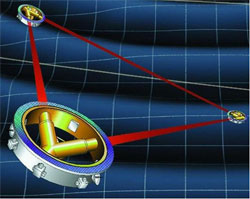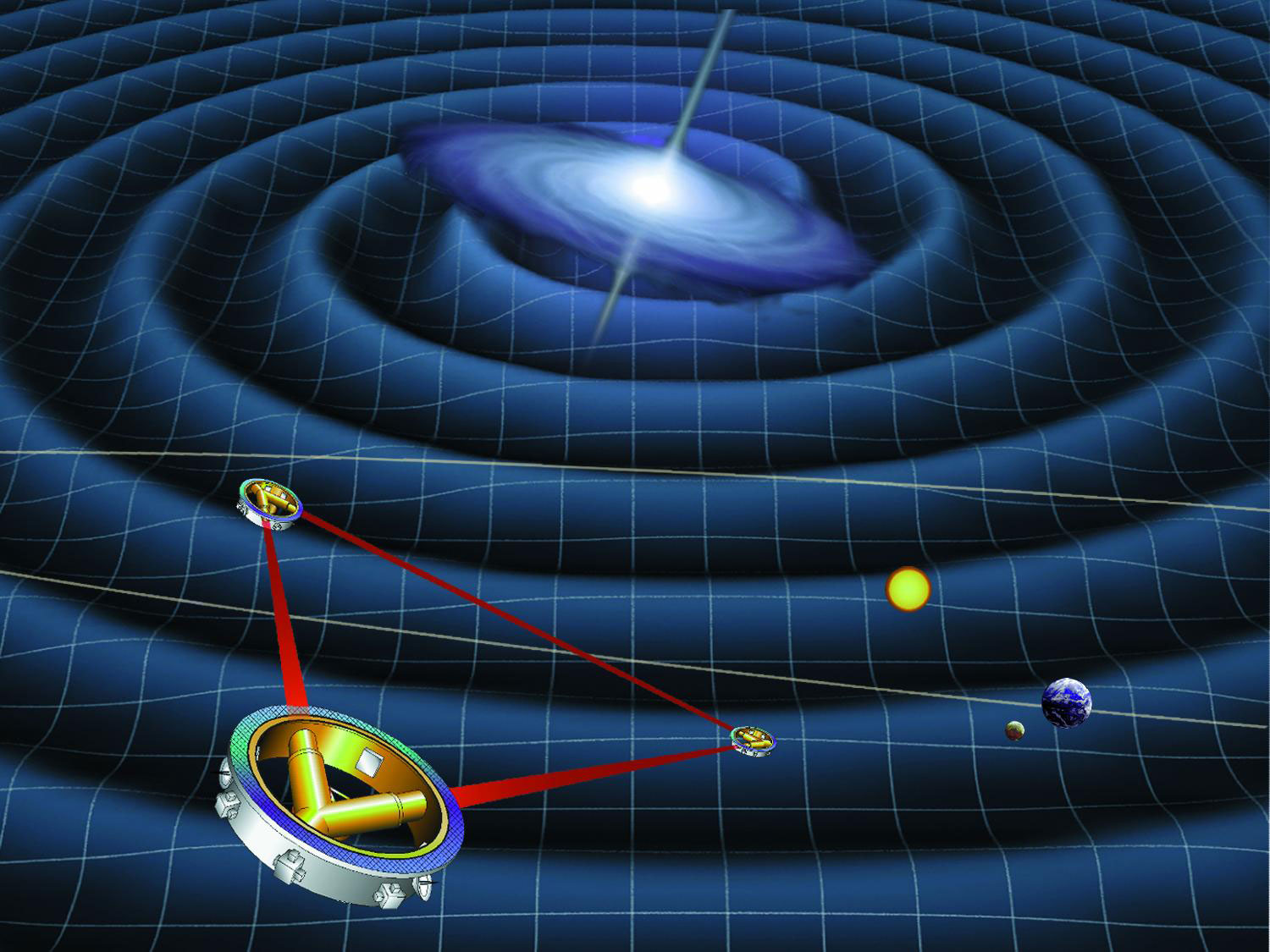Testing for Vanishing Dimensions
A recent theory solves some problems in cosmology and particle physics by proposing that the early universe contained fewer spatial dimensions than the three we see today. In the 11 March Physical Review Letters, a team describes a specific test of the theory using LISA, a planned, space-based observatory for gravitational waves. The theorists say the waves can’t exist in fewer than three dimensions, so above a certain frequency–representing the oldest waves–LISA should see no primordial waves. Although the theory is speculative, some researchers believe cosmic ray data has already shown hints of vanishing dimensions at high energies. The team says the new test would be more conclusive than previous results.
The vanishing dimensions hypothesis predicts that, at extremely high energies and temperatures, the three dimensions of space that we are familiar with reduce to two, or even one dimension [1]. So in the hot conditions of the very early universe, there would have been fewer dimensions, and then, as the universe cooled, additional spatial dimensions would have appeared, one-by-one. The theory also proposes that our current universe has four spatial dimensions, but we only experience a three-dimensional “slice” of it. The appearance of the fourth spatial dimension gave rise to extra energy, which generated a boost to the expansion of the universe, according to the theory. This boost could explain the accelerating expansion of the universe that was discovered in 1998 and that is usually described as resulting from a mysterious “dark energy” pervading the universe. The theory also solves some problems in particle physics, says Dejan Stojkovic of the State University of New York at Buffalo.
Evidence of vanishing dimensions may already have been detected in cosmic ray showers in the Earth’s atmosphere. A 2005 reanalysis of cosmic ray data showed that the jets of particles produced by the most energetic cosmic rays were aligned closer to a plane than would be expected, which could signify dimension reduction [2]. Other researchers are planning to use the Large Hadron Collider (LHC), the particle accelerator outside Geneva, to test for vanishing dimensions. If dimensions vanish at very high energies, then the particles produced in collisions would be confined to a 2-dimensional plane instead of a 3-dimensional volume.
But interpreting the LHC data may not be easy because different models will have different predictions, says Stojkovic. So he and Jonas Mureika of Loyola Marymount University in Los Angeles looked for a definitive test. They decided on gravitational waves–ripples in spacetime caused by large-scale events in the cosmos–which cannot exist in fewer than three spatial dimensions, says Stojkovic. “You can’t get around the non-existence of gravity waves” at the earliest times in the theory, he says.
The idea is that the highest frequency primordial gravitational waves correspond to the highest energies and the earliest times. So there should be a maximum frequency of the observed waves–higher frequencies could not exist because they would come from the fewer-dimension era. Stojkovic and Mureika have now calculated this frequency cutoff to be about Hz, subject to some assumptions. They say this is within the range accessible to the Laser Interferometer Space Antenna (LISA), a future space-based gravitational wave detector that is a joint project between NASA and the European Space Agency. Stojkovic and Mureika are already working with gravitational wave experimentalists from several US universities to prepare a test of their proposal using computer simulations. “This regime is extremely interesting to probe by observations, if that is possible at all,” says Martin Bojowald, a theorist at Pennsylvania State University in State College. He says the paper is “promising, if one tries to draw reliable conclusions in the absence of a detailed underlying theory.” Stojkovic acknowledges the lack of details in the theory and intends to elucidate them in collaboration with others.
Szabolcs Marka of Columbia University in New York says that vanishing dimensions may be one of many alternative theories for LISA to investigate. However, it will take some time. “LISA is probably about ten years in the future, so even if the idea works, we will not have observational evidence to assess it for a long time,” says Marka.
–Saswato R. Das
Saswato R. Das is a freelance science writer in New York City.
References
- R. Loll and Nucl. Phys. B, Proc. Suppl. 94, 96 (2001); J. Ambjørn, J. Jurkiewicz, and R. Loll, Phys. Rev. D 72, 064014 (2005); L. Modesto and P. Nicolini, 81, 104040 (2010)
- R. A. Mukhamedshin, J. High Energy Phys. 05 (2005) 049; T. Antoni and et al., Phys. Rev. D 71, 072002 (2005)





